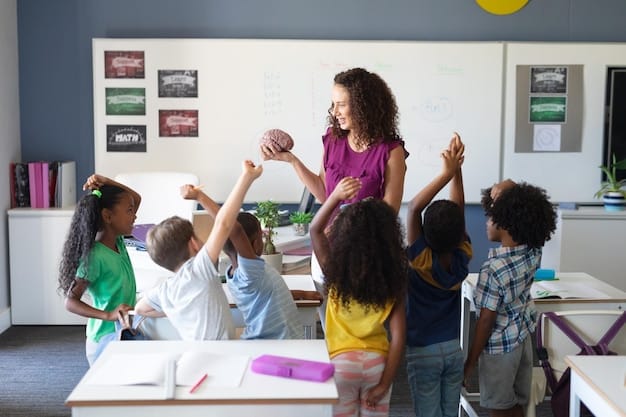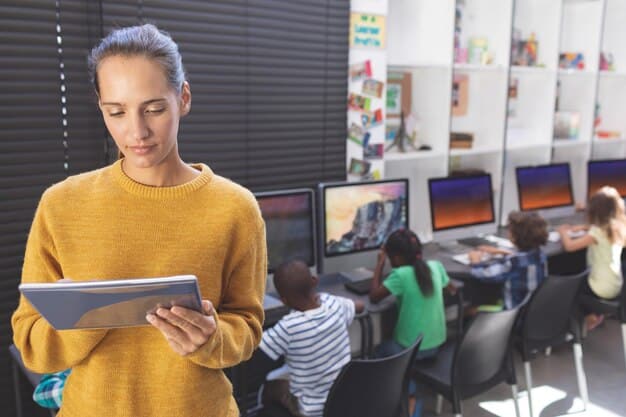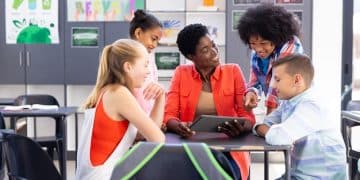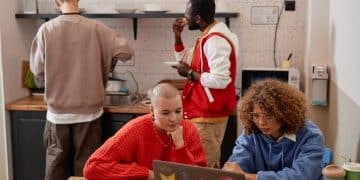Expert Insights: Research on Effective Teaching Strategies

Navigating the complexities of modern education requires a deep understanding of effective teaching strategies tailored for diverse learners, a critical area where recent research provides invaluable insights for educators seeking to foster inclusive and impactful learning environments, ensuring equitable opportunities for all.
In the dynamic landscape of modern education, fostering an inclusive and effective learning environment for every student is paramount. Recent advancements in pedagogical research offer an unprecedented look into what truly works, and how educators can adapt their practices to meet the varied needs of learners. This article explores Expert Insights: Understanding the Latest Research on Effective Teaching Strategies for Diverse Learners, diving into evidence-based approaches designed to empower every student.
Embracing Differentiated Instruction Approaches
Differentiated instruction is not a new concept, but its application continues to evolve with deeper research into cognitive science and individual learning pathways. This approach acknowledges that students come to the classroom with varied backgrounds, readiness levels, and learning styles. Effective differentiation involves tailoring content, process, products, and learning environments to meet these diverse needs, ensuring every student can access and engage with the curriculum in a meaningful way.
Recent studies emphasize the importance of flexible grouping within differentiated instruction. This means moving away from static groups based on ability and instead forming groups that shift based on a particular learning objective or task. This dynamic approach allows students to experience various roles and collaborate with different peers, fostering both academic and social-emotional growth.
Personalized Learning Pathways
The core of differentiated instruction lies in creating personalized learning pathways. This goes beyond simply providing different worksheets. It involves a continuous assessment of student progress and understanding, allowing teachers to adjust their strategies in real-time. Technology plays a crucial role here, with adaptive learning platforms offering tailored exercises and direct feedback, empowering students to learn at their own pace.
- Provide multiple means of representation for content.
- Offer varying levels of scaffolding based on student need.
- Allow choice in learning activities and outcomes.
Assessment for Learning
Effective differentiation relies heavily on ongoing formative assessment. This isn’t about grading, but about gathering information to inform instruction. Short quizzes, exit tickets, observations, and student self-reflections all provide valuable data. When teachers truly understand where each student is, they can better tailor their lessons to bridge gaps and push boundaries.
Furthermore, research highlights the benefits of involving students in the assessment process. When students understand the learning objectives and criteria for success, they become more invested in their own learning journey. This metacognitive awareness empowers them to self-regulate and take ownership of their progress.
Culturally Responsive Pedagogy and Its Impact
Culturally responsive pedagogy (CRP) has emerged as a cornerstone of effective teaching for diverse learners. It challenges traditional, Eurocentric teaching models by advocating for an educational approach that respects and incorporates students’ cultural backgrounds, experiences, and languages into the curriculum and classroom practices. CRP is about seeing students’ cultural identities as assets, not as obstacles.
This pedagogical framework involves more than just decorating classrooms with diverse images. It requires deep self-reflection from educators about their own biases and assumptions, and a genuine effort to understand the diverse backgrounds of their students. When students see their cultures reflected positively in their learning environment, they feel a greater sense of belonging and engagement, leading to improved academic outcomes.
Bridging Home and School Cultures
A key aspect of CRP is the deliberate act of bridging the gap between students’ home cultures and the school culture. This can involve inviting family members to share their traditions, integrating community stories into lesson plans, or even learning basic phrases in students’ native languages. These efforts signal respect and validate students’ identities, making the learning process more relevant and meaningful.
- Infuse diverse perspectives into all subject areas.
- Use literature and media that reflect global cultures.
- Encourage students to share personal stories and experiences.
Promoting Critical Consciousness
Beyond inclusion, CRP aims to foster critical consciousness among students. This means equipping them with the tools to analyze and challenge societal inequities. By engaging with real-world issues and discussing social justice, students develop a deeper understanding of their own place in the world and their potential to effect positive change. This critical engagement not only enhances academic skills but also cultivates active and responsible citizens.
Leveraging Technology for Inclusive Learning
The rapid advancement of educational technology offers unprecedented opportunities for making learning more accessible and equitable for diverse learners. From assistive technologies to personalized learning platforms, digital tools can address a wide range of learning needs and preferences, breaking down barriers that might exist in traditional classroom settings. Technology, when used thoughtfully, can truly transform the learning experience.
It’s not just about having devices; it’s about how they are integrated into the pedagogical approach. Merely digitizing worksheets doesn’t enhance learning. Instead, educators must strategically employ technology to offer multiple pathways for content consumption, expression, and engagement, aligning with principles of Universal Design for Learning (UDL).
Adaptive Learning Platforms
Adaptive learning platforms utilize algorithms to adjust the difficulty and content of material based on a student’s performance. This ensures that content is neither too easy nor too challenging, maintaining optimal engagement and promoting continuous growth. Such platforms can provide immediate feedback, identify areas of struggle, and suggest supplementary resources, acting as a personal tutor for each student.

Assistive Technologies
For students with disabilities, assistive technologies (AT) are game-changers. Screen readers, speech-to-text software, alternative input devices, and communication aids empower students to participate fully in the learning process. Educators must be knowledgeable about available AT and how to integrate them seamlessly into their instruction, ensuring equitable access to information and opportunities for expression.
- Utilize interactive whiteboards for dynamic lessons.
- Incorporate educational apps that support various learning styles.
- Explore virtual reality to offer immersive learning experiences.
Fostering Digital Citizenship
Beyond skill development, integrating technology also means teaching digital citizenship. Students need to learn how to navigate the online world responsibly, ethically, and safely. This includes understanding digital footprints, recognizing misinformation, practicing respectful online communication, and protecting personal privacy. These are essential life skills in the 21st century.
The Power of Social-Emotional Learning (SEL)
Social-emotional learning (SEL) has gained immense traction in educational research as a vital component of holistic student development. SEL is the process through which children and adults acquire and effectively apply the knowledge, attitudes, and skills necessary to understand and manage emotions, set and achieve positive goals, feel and show empathy for others, establish and maintain positive relationships, and make responsible decisions. For diverse learners, SEL is particularly crucial.
Students from challenging backgrounds, or those navigating new cultural contexts, often face unique social and emotional hurdles. Integrating SEL into the curriculum helps create a supportive and inclusive classroom climate where every student feels safe, valued, and connected. This foundational sense of well-being is a prerequisite for effective academic learning.
Building Relationships and Community
At its heart, SEL emphasizes relationship building. When students feel a strong connection to their peers and teachers, they are more likely to take risks, engage in discussions, and seek help when needed. Teachers can foster this by creating opportunities for collaborative work, incorporating restorative justice practices, and dedicating time for community-building activities.
- Teach explicit social-emotional skills like empathy and conflict resolution.
- Create a safe space for emotional expression.
- Encourage peer support and mentorship programs.
Resilience and Self-Regulation
SEL equips students with critical skills for resilience and self-regulation. Learning to manage stress, cope with setbacks, and regulate impulses are not just “soft skills”; they are essential for academic success and life beyond school. These skills are especially important for diverse learners who may encounter more varied challenges inside and outside the classroom.
By teaching students to identify their emotions and develop healthy coping mechanisms, educators empower them to navigate adversity with greater confidence. This self-awareness and self-management directly contribute to a student’s capacity to learn and thrive in any environment.
Neuroscience Insights into Learning
The burgeoning field of neuroscience is providing unprecedented insights into how the brain learns, offering evidence-based strategies that can significantly enhance teaching practices for all students, particularly diverse learners. Understanding the brain’s plasticity, the role of emotions in learning, and the impact of stress opens new avenues for optimizing instructional design and classroom environments. Neuroscience helps us move beyond trial-and-error to more informed pedagogical choices.
For instance, research on memory consolidation suggests that spaced repetition and retrieval practice are far more effective than rote memorization. Understanding how the brain responds to novelty and challenge can help teachers design engaging lessons that capture and sustain attention. These insights are not just theoretical; they offer practical guidance for educators.
The Role of Emotion and Stress
Neuroscience confirms what many educators intuitively know: emotions play a critical role in learning. A relaxed, safe, and positive emotional state enhances cognitive function, while chronic stress or fear can actively inhibit learning by activating the brain’s threat response. This is particularly relevant for diverse learners who may face external stressors. Creating a low-stress, nurturing environment is not just good practice, it’s neuroscience-backed.
- Incorporate movement and physical activity into lessons.
- Vary teaching methods to stimulate different brain areas.
- Provide frequent, constructive feedback to reinforce learning pathways.
Cognitive Load Theory Applied
Cognitive load theory, rooted in neuroscience, emphasizes the limitations of working memory. It suggests that instructions should be designed to minimize extraneous cognitive load while optimizing germane cognitive load (the mental effort involved in constructing schemas). This means breaking down complex tasks, providing clear instructions, and avoiding information overload, which benefits all learners, especially those with learning differences or language barriers.

Metacognition and Self-Regulation
Neuroscience also highlights the power of metacognition—thinking about one’s own thinking. When students are taught strategies for planning, monitoring, and evaluating their learning, they develop stronger neural connections related to self-regulation. This empowers them to become more independent and effective learners, capable of adapting to new challenges. Encouraging students to reflect on their learning processes, what worked, and what didn’t, builds these essential pathways.
Collaborative Learning and Peer Interactions
Collaborative learning strategies, where students work together in small groups or pairs to achieve a common goal, are consistently shown to be highly effective for diverse learners. This approach leverages the power of peer interaction, allowing students to learn from each other, articulate their understanding, and develop crucial social and communication skills. It shifts the teacher’s role from sole deliverer of content to facilitator of learning, creating a more dynamic and engaging classroom.
When students of varying abilities and backgrounds collaborate, they bring different perspectives to the table, enriching the learning experience for everyone. This cooperative environment fosters a sense of shared responsibility and mutual respect, which are vital ingredients for an inclusive classroom. The process of explaining concepts to others can deepen one’s own understanding. It also provides opportunities for students to lead and follow, strengthening their interpersonal skills.
Structured Group Work
Effective collaborative learning isn’t just about putting students in groups; it requires careful structuring and support. Teachers must clearly define roles, establish expectations, and provide criteria for success. Strategies like jigsaw, where each student becomes an expert on a sub-topic and then teaches it to their group, ensure active participation and shared responsibility.
- Assign specific roles within groups to ensure participation.
- Teach active listening and respectful disagreement strategies.
- Provide feedback on group processes as well as outcomes.
Peer Tutoring Benefits
Peer tutoring is another powerful collaborative strategy. When a student teaches another, both benefit. The tutor gains a deeper understanding of the material and develops leadership skills, while the tutee receives individualized support in a less intimidating environment. This is particularly effective for diverse learners who might feel more comfortable asking questions of a peer than a teacher.
Research indicates that peer tutoring can significantly improve academic performance, boost confidence, and foster positive relationships among students. It also promotes empathy and understanding across different learning styles and abilities.
Addressing Language Diversity with Multilingual Support
In classrooms with diverse learners, language diversity is a significant factor. Students who are English Language Learners (ELLs) or come from multilingual backgrounds require specific strategies to ensure they can access the curriculum and thrive academically. An effective approach goes beyond simply translating materials; it involves creating a language-rich environment that supports linguistic development while simultaneously teaching academic content.
Recognizing the value of students’ home languages is paramount. Research indicates that maintaining and developing proficiency in the first language can actually facilitate the acquisition of a second language. Therefore, educators should view multilingualism as a strength, not a deficit, and incorporate strategies that leverage students’ existing linguistic assets. This inclusive approach empowers students to use their full linguistic repertoire in their learning journey.
Scaffolding Language Acquisition
Scaffolding is crucial for ELLs. This involves providing temporary support to help students bridge the gap between their current language proficiency and the language demands of the content. Strategies include using visuals, gestures, simplified language, graphic organizers, and sentence starters. Teachers should also pre-teach vocabulary and key concepts, and provide opportunities for students to engage in low-stakes language production.
- Provide dual-language texts or glossaries.
- Encourage the use of translation tools when appropriate.
- Implement sheltered instruction observation protocol (SIOP) model.
Promoting Academic Language
Beyond conversational English, students need to develop academic language – the specialized vocabulary and grammatical structures used in school. This involves explicit instruction on terms specific to subject areas, how to construct academic arguments, and how to analyze complex texts. Teachers should model academic language and provide ample opportunities for students to practice it in both oral and written forms.
A focus on academic language ensures that multilingual learners are not only able to communicate generally but are also equipped with the linguistic tools necessary to succeed in higher-level content areas and standardized assessments. This deliberate approach helps bridge the language gap often faced by diverse learners in mainstream classrooms.
| Key Strategy | Brief Description |
|---|---|
| 🎯 Differentiated Instruction | Tailoring content, process, products, and environment to meet varied student needs. |
| 🌍 Culturally Responsive Pedagogy | Integrating students’ cultural backgrounds into curriculum and practices. |
| 🤝 Collaborative Learning | Students working together to achieve shared learning goals. |
| 🧠 Neuroscience-Informed Teaching | Applying brain research to optimize learning environments and instruction. |
Frequently Asked Questions
Differentiated instruction is a teaching philosophy that recognizes and plans for the individual differences among students in a classroom. It’s crucial for diverse learners because it allows educators to tailor content, process, products, and learning environments, ensuring every student, regardless of their unique needs or background, can effectively access and engage with the curriculum.
Culturally responsive pedagogy benefits students by affirming their cultural identities, making learning more relevant and engaging. By integrating students’ backgrounds into the curriculum and teaching practices, it fosters a sense of belonging, boosts self-esteem, and improves academic outcomes, especially for those from marginalized or underrepresented groups. It helps bridge the gap between home and school cultures.
Technology offers significant support for diverse learners by providing accessible and personalized learning experiences. Tools like adaptive learning platforms, assistive technologies (e.g., screen readers), and interactive software can cater to various learning styles and needs, breaking down traditional barriers. It allows for differentiated content delivery and varied means of expression, enhancing inclusivity.
Social-emotional learning (SEL) is critical because it equips students with the skills to understand and manage emotions, set goals, show empathy, build relationships, and make responsible decisions. For diverse learners, SEL helps create a safe and supportive classroom climate, fostering resilience and self-regulation. These foundational skills are essential for both academic achievement and overall well-being.
Teachers can effectively support multilingual learners by valuing their home languages and providing strategic scaffolding for English language acquisition. This includes using visuals, simplified language, and pre-teaching vocabulary. Explicit instruction in academic language, fostering a language-rich environment, and encouraging both verbal and written practice are also key to their success.
Conclusion
The journey toward truly effective and equitable education for all learners is continuous, guided by ongoing research and innovative practices. The insights gleaned from recent studies underscore a fundamental shift: away from a one-size-fits-all model towards a nuanced, responsive, and deeply personalized approach. By prioritizing differentiated instruction, culturally responsive pedagogy, strategic technology integration, social-emotional learning, neuroscience-informed teaching, collaborative learning, and robust multilingual support, educators can construct learning environments that not only address but celebrate the rich diversity of their students. Investing in these evidence-based strategies is not merely an educational best practice; it is an imperative for nurturing a generation of resilient, engaged, and equitably educated individuals ready to thrive in an ever-evolving world. The future of education lies in our collective ability to apply these expert insights, ensuring every learner reaches their fullest potential.





